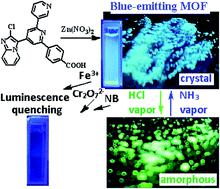当前位置:
X-MOL 学术
›
J. Mater. Chem. C
›
论文详情
Our official English website, www.x-mol.net, welcomes your feedback! (Note: you will need to create a separate account there.)
A new porous coordination polymer reveals selective sensing of Fe3+, Cr2O72−, CrO42−, MnO4− and nitrobenzene, and stimuli-responsive luminescence color conversions
Journal of Materials Chemistry C ( IF 6.4 ) Pub Date : 2020-07-16 , DOI: 10.1039/c9tc07030c Bin Li 1, 2, 3, 4 , Qing-Qing Yan 1, 2, 3, 4 , Guo-Ping Yong 1, 2, 3, 4
Journal of Materials Chemistry C ( IF 6.4 ) Pub Date : 2020-07-16 , DOI: 10.1039/c9tc07030c Bin Li 1, 2, 3, 4 , Qing-Qing Yan 1, 2, 3, 4 , Guo-Ping Yong 1, 2, 3, 4
Affiliation

|
A novel one-dimensional spiro-like chain coordination polymer with a blue-emission signal was solvothermally synthesized via the reaction of Zn2+ ions with organic ligand HL (4-(4-(2-chloroimidazo[1,2-a]pyridin-3-yl)-[2,3′-bipyridin]-6-yl)benzoic acid), which is further extended to a porous three-dimensional supramolecular framework, namely, the porous coordination polymer (PCP), [Zn(L)2]·2DMF (USTC-5). This PCP was characterized by IR spectroscopy, thermogravimetry, and single-crystal, and powder X-ray diffraction methods. USTC-5 possesses larger quasi-hexagonal channels with Lewis-base sites, and is a better CO2 adsorption or promising CO2/N2 selective material, suggesting potential application in gas separation. USTC-5 also can serve as a multi-responsive sensing material for detecting Fe3+, Cr2O72−, CrO42−, MnO4− and nitrobenzene (NB). Moreover, the mechanism of the selective luminescence quenching response for Cr2O72−, CrO42−, MnO4− and NB can be mainly ascribed to the competitive adsorption of excitation wavelength energy between USTC-5 and Cr2O72−, CrO42−, MnO4− or NB; meanwhile, Fe3+ ions diffused into the channels of USTC-5 and formed contacts with Lewis-base sites in USTC-5, leading to luminescence quenching. Significantly, USTC-5 displays reversible luminescence color switching in response to acid–base vapor stimuli, which originates from the conversion between the amorphous form and the crystal mediated by protonation–deprotonation processes. Such a stimuli-responsive conversion provides a promising approach to design and construct smart PCP materials.
中文翻译:

一种新型的多孔配位聚合物揭示了Fe3 +,Cr2O72−,CrO42−,MnO4−和硝基苯的选择性感测以及刺激响应的发光颜色转换
通过Zn 2+离子与有机配体HL(4-(4-(2-氯咪唑并[1,2- a ]吡啶])的反应,溶剂热合成了具有蓝色发射信号的新型一维螺旋状链状配位聚合物。-3-基)-[2,3'-联吡啶] -6-基)苯甲酸),它进一步扩展到多孔三维超分子骨架,即多孔配位聚合物(PCP),[Zn(L )2 ]·2DMF(USTC-5)。该PCP通过红外光谱,热重分析,单晶和粉末X射线衍射方法进行了表征。USTC-5具有较大的带有Lewis基点的准六边形通道,并且是较好的CO 2吸附或有希望的CO 2 / N 2选择性材料,提示其在气体分离中的潜在应用。USTC-5也可以作为用于检测的Fe多响应感测材料3+,铬2 ö 7 2-,的CrO 4 2-,MnO的4 -和硝基苯(NB)。此外,对Cr选择性发光猝灭反应的机制2 Ó 7 2-,的CrO 4 2-,MnO的4 -和NB能够主要归因于激发波长能量的竞争吸附之间USTC -5-和Cr 2 ö 7 2-,的CrO 4 2-,MnO的4 -或NB; 与此同时,铁3+离子扩散到的信道USTC-5和形成的触点与路易斯碱位USTC-5 ,导致发光猝灭。值得注意的是,USTC-5响应于酸碱蒸汽刺激而显示出可逆的发光颜色切换,这源于质子-去质子化过程介导的无定形形式与晶体之间的转换。这种刺激响应转换为设计和构造智能PCP材料提供了一种有前途的方法。
更新日期:2020-09-03
中文翻译:

一种新型的多孔配位聚合物揭示了Fe3 +,Cr2O72−,CrO42−,MnO4−和硝基苯的选择性感测以及刺激响应的发光颜色转换
通过Zn 2+离子与有机配体HL(4-(4-(2-氯咪唑并[1,2- a ]吡啶])的反应,溶剂热合成了具有蓝色发射信号的新型一维螺旋状链状配位聚合物。-3-基)-[2,3'-联吡啶] -6-基)苯甲酸),它进一步扩展到多孔三维超分子骨架,即多孔配位聚合物(PCP),[Zn(L )2 ]·2DMF(USTC-5)。该PCP通过红外光谱,热重分析,单晶和粉末X射线衍射方法进行了表征。USTC-5具有较大的带有Lewis基点的准六边形通道,并且是较好的CO 2吸附或有希望的CO 2 / N 2选择性材料,提示其在气体分离中的潜在应用。USTC-5也可以作为用于检测的Fe多响应感测材料3+,铬2 ö 7 2-,的CrO 4 2-,MnO的4 -和硝基苯(NB)。此外,对Cr选择性发光猝灭反应的机制2 Ó 7 2-,的CrO 4 2-,MnO的4 -和NB能够主要归因于激发波长能量的竞争吸附之间USTC -5-和Cr 2 ö 7 2-,的CrO 4 2-,MnO的4 -或NB; 与此同时,铁3+离子扩散到的信道USTC-5和形成的触点与路易斯碱位USTC-5 ,导致发光猝灭。值得注意的是,USTC-5响应于酸碱蒸汽刺激而显示出可逆的发光颜色切换,这源于质子-去质子化过程介导的无定形形式与晶体之间的转换。这种刺激响应转换为设计和构造智能PCP材料提供了一种有前途的方法。


























 京公网安备 11010802027423号
京公网安备 11010802027423号